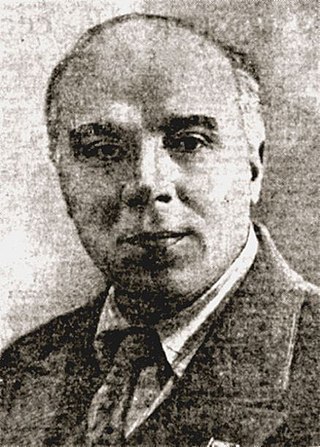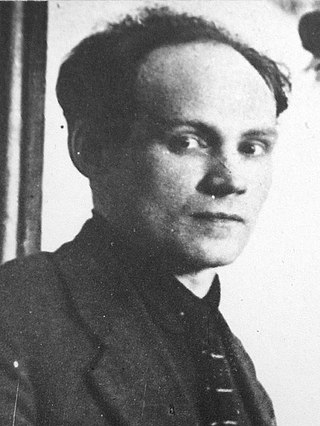
Kliment Yefremovich Voroshilov, popularly known as Klim Voroshilov, was a prominent Soviet military officer and politician during the Stalin-era. He was one of the original five Marshals of the Soviet Union, the second highest military rank of the Soviet Union, and served as Chairman of the Presidium of the Supreme Soviet, the nominal Soviet head of state, from 1953 to 1960.

Nikolai Viktorovich Podgorny was a Soviet statesman who served as the Chairman of the Presidium of the Supreme Soviet, the head of state of the Soviet Union, from 1965 to 1977.
Marshal of the Soviet Union was the second-highest military rank of the Soviet Union. Joseph Stalin wore the uniform and insignia of Marshal after World War II.
A presidium or praesidium is a council of executive officers in some countries' political assemblies that collectively administers its business, either alongside an individual president or in place of one. The term is also sometimes used for the governing body of European non-state organisations.

Hryhoriy Fedorovych Hrynko was a Soviet Ukrainian statesman who held high office in the government of the Soviet Union. He served as finance minister of the Soviet Union in Moscow, from 1930 to 1937, replacing Nikolai Bryukhanov.

The Government of the Union of Soviet Socialist Republics (USSR) was the executive and administrative organ of the highest body of state authority, the All-Union Supreme Soviet. It was formed on 30 December 1922 and abolished on 26 December 1991. The government was headed by a chairman, most commonly referred to as the premier of the Soviet Union, and several deputy chairmen throughout its existence. The Communist Party of the Soviet Union (CPSU), as "The leading and guiding force of Soviet society and the nucleus of its political system" per Article 6 of the state constitution, controlled the government by holding a two-thirds majority in the All-Union Supreme Soviet. The government underwent several name changes throughout its history, and was known as the Council of People's Commissars from 1922 to 1946, the Council of Ministers from 1946 to 1991, the Cabinet of Ministers from January to August 1991 and the Committee on the Operational Management of the National Economy from August to December 1991.
Vladimir Nikolaevich Druzhinin was a Soviet state and party leader, a Hero of the Soviet Union during World War II and an active participant in the partisan movement in Ukraine through the Chernihiv Commissioner-Volyn. In February 1940, Druzhinin was elected second secretary of the Communist Party's Ternopil oblast committee, a post in which he served until July 1941. By a Decree of the Presidium of the Supreme Soviet of the USSR dated 4 January 1944, for organizing a guerrilla movement behind enemy lines against the Nazis, Druzhinin was named a Hero of the Soviet Union with the Order of Lenin and Gold Star number 2884.

Mykhailo Mykolayovych Poloz was a Ukrainian and Soviet politician, diplomat, and statesman, and a participant at the Treaty of Brest-Litovsk.

Alexei Ivanovich Rykov was a Russian Bolshevik revolutionary and a Soviet politician and statesman, most prominent as premier of Russia and the Soviet Union from 1924 to 1929 and 1924 to 1930 respectively. He was one of the accused in Joseph Stalin's show trials during the Great Purge.

The Premier of the Soviet Union was the head of government of the Union of Soviet Socialist Republics (USSR). From 1923 to 1946, the name of the office was Chairman of the Council of People's Commissars, and from 1946 to 1991 its name was Chairman of the Council of Ministers. During the dissolution of the Soviet Union in 1991, its name was briefly Prime Minister and Chairman of the Committee on the Operational Management of the Soviet Economy. The first Soviet premier was the country's founder and first leader, Vladimir Lenin. After 1924, when General Secretary of the Communist Party Joseph Stalin rose to power, the de facto leader was the party's General Secretary, with Stalin and his successor Nikita Khrushchev also serving as premier. Twelve individuals held the post.

Nikolai Kirillovich Antipov was a Soviet politician. He was appointed Member of the Central Executive Committee of the Soviet Union and elected member of the Central Committee of the Communist Party of the Soviet Union (1924–1937) and candidate member of the Orgburo. He was executed during the Great Purge and rehabilitated posthumously.

Nikolai Pavlovich Komarov was a Russian Soviet politician, statesman and Communist Party official.

Konstantin Vasilievich Ukhanov was a Soviet politician and statesman.
Semyon Semyonovich Lobov was a Soviet statesman and politician.

Saftar Mammad oghlu Jafarov was an Azerbaijani politician, Chairman of the Presidium of the Supreme Soviet of Azerbaijan SSR (1959–1961).
Isidor Yevstigneyevich Lyubimov was a Russian revolutionary and Soviet politician. Lyubimov was Mikhail Frunze's closest associate during the Russian Revolution and Civil War.

Alexei Vasilievich Medvedev was a Soviet politician and trade union leader.
Mariya Andriivna Orlyk was a Ukrainian teacher and Communist Party of the Soviet Union politician. She began teaching in the village called Zolotnyky in the Ternopil Oblast following her graduation from the Faculty of History of the Volodymyr Vynnychenko Central Ukrainian State Pedagogical University. in 1953. Orlyk taught history and was headmaster of the rural Zolotnikovskaya Secondary School. She served as a Deputy of the Supreme Soviet of the Ukrainian SSR between 1975 and 1989 and was deputy chair of the Council of Ministers of the Ukrainian SSR from April 1978 to 1990.
Ivan Grigoryevich Kabanov was a Soviet statesman. He was a candidate for the members of the Presidium of the 19th Congress of the Communist Party of the Soviet Union from 1952 to 1953, Minister of Foreign Trade of the USSR from 1953 to 1958, and a laureate of the Stalin Prize in 1953.











